
Citation: Amini MH and Hamdam SM. Medicinal Plants Used Traditionally in Guldara District of Kabul, Afghanistan. Int J Pharmacogn Chinese Med 2017, 1(3): 000118.
*Corresponding author: Amini MH, Assistant Professor, Department of Pharmacognsoy, Faculty of Pharmacy, Kabul University, Jamal mina, Kabul, Afghanistan, Email: m_hamayon@yahoo.com
Medicinal plants are traditionally used in different parts of Afghanistan since long back. Guldara is one of the districts of Kabul province where numerous plants are traditionally used in treatment of a wide range of routine diseases such as; gastrointestinal disorders, urinary tract infections, respiratory problems, skin diseases, cardiovascular diseases, and so on. But, published records of folk and traditional health approaches practiced in Guldara as well as other parts of Afghanistan are still very scarce. Ethnopharmacological field studies not only contribute in the public health domain but also serve as the basis for further pharmaceutical and medical researchers. In such context, present field study aims to record the plant crude drugs used traditionally in eight villages of Guldara district. Data were collected through questionnaires replied by local healers or akims, experienced elder individuals and patients using herbal crude drugs. Botanical name, family, common Dari/Pushto names, parts used, preparations and administration route, and indications of total 68 plants belonging to 30 families, and used by Guldara residents are reported in this paper. Herbarium specimens of 20 species were also prepared, and after being authenticated, were deposited in herbarium of Pharmacy faculty, Kabul University, for further use. Additional researches are emphasized for phytochemical and pharmacological studies of these plants to prove their rational usages by the rural people. Similarly, more works are required for reporting medicinal plants traditionally used in other parts of Kabul, and those of entire Afghanistan.
Keywords: Afghanistan; Guldara district; Medicinal plants; Traditional usage
Abbreviations: MPs: Medicinal Plants; KUFS: Kabul University Faculty of Science
IntroductionMankind has been using medicinal plants (MPs) for treatment of their diseases, even in time immemorial. As per WHO, more than 80% of world population rely on MPs and natural drugs to solve their primary health problems [1,2]. Traditional medicine is used based on previous generation’s believes and practices of natural drugs, particularly of MPs. Traditional and complementary medicines are widely used in different countries of the world and valued for a number of reasons prominently for their cultural acceptability, accessibility and affordability [3,4]. As far as ascertained, a large number of MPs used traditionally, have been investigated for their pharmacological potential and secondary metabolites [5-7].
Around the world, people interest is growing toward usage of herbal remedies, since they are accounted as safe, cheap and accessible health care approaches [8,9]. In Afghanistan, herbal medication or more commonly natural medication is practiced under the name of Unani medication, since long buck. In different part of Kabul city, there are numerous Unani or Loqmani pharmacies locally called “Attari or عطاری “where akims are prescribing herbal crude drugs and herbal preparations to the patients referring them.
Afghanistan as a mountainous country has a unique plant flora comprising around 5000 species out of which 25 - 30% are endemic to this country [10,11]. Various MPs growing wildly in this country, and also some imported crude drugs, has been traditionally used by Afghan people for treatment of a wide range of routine diseases, since long back. As, 215 medicinal plants including some imported crude drugs used traditionally in Afghanistan, have been already reported [12]. Likewise, some MPs used by indigenous people of Tajik and Afghan Pamirs are also reported [8]. But publications regarding MPs growing in different parts of Afghanistan are still very scarce. The long-lasting wars and conflicts in this country could be accounted as the main reason for lake of comprehensive researches and publications regarding MPs diversity, and their folklore and traditional uses in different parts of the country.
Guldara is one of the 15 districts of Kabul province, Afghanistan. It is located at around 1800 m altitude from sea level, in northwestern part at 20 km far from Kabul, at 69o, 1’, 48’’ eastern longitude, and 34o, 41’, 48’’ northern latitude [13]. The district is called Guldara (meaning valley of the flower) because of its beauty during spring season, when most of its land is covered by wildly grown flowers such as tulips. Guldara hosts more than 25000 residents, who are mostly farmers having moderate economic condition. Common agricultural products of the district are; wheat, maize, potato, apple, pear, peach, grape, mulberry, and walnut [14]. A diverse array of wild plants with high medicinal potential also grows in Guldara.
Guldara residents are culturally very eager to use herbal drugs for curing their routine ailments such as; gastrointestinal disorders, urinary tract infections, respiratory problems, skin diseases, cardiovascular diseases, etc. The people claim that MPs are easily accessible, freely available or of lower cost as compared with modern synthetic medicine (personal communication). Inevitably, in case of severe illnesses people ought to refer to the hospitals located in Kabul city, and would afford the high prices of synthetic medicine. Present study was aimed to document the plants used in traditional system of eight villages of Guldara district namely; Dehnaw-e-Guldara, Deh bedack village, Jalwani village, Tulat village, Bagh ha-e-Dehnaw, Nassiri village, Qol-e-nemat village, and Deh bala village. The specific objectives of this study are:
Botanical name, common local names, parts used, medicinal usages, and mode of preparation and administration of the plants used in eight villages of Guldara district are reported for the first time in this paper. However, similar researches are emphasized to be performed for local health documentation and enlisting MPs used in other parts of Afghanistan, as well.
Material and methodsInformation was attained from eight villages of Guldara district. Local community healers called akims, and old individuals having enough experiences of herbal therapy and traditional medicines were interviewed and asked through open ended questions of a prepared questionnaire. Following information was gathered during the discussion or interview:
Convenient sampling and snowball sampling methods were used in selection of akims and experienced individuals, respectively. Meanwhile, appropriate discussions were carried out with local villagers and patients in respect of traditional use of plants in their villages. If necessary, the informants were asked to indicate the target MPs growing in their surrounding area. If required and applicable, specimens of the shown plants were also collected for herbarium preparation and botanical authentication. Most of the common and known plants were botanically identified by the authors, while the confused plants were identified by Prof. MN Sediqi, Head of Pharmacognosy Dept. faculty of Pharmacy, Kabul University. Voucher specimens of Kabul University, Faculty of Science (KUFS) herbarium, the sheets existed in herbarium of Pharmacy Faculty, and the book Field Guide Afghanistan: Flora and Vegetation written by Breckle, et al. [10] were used as references for botanical authentication of the collected plant samples. After being authenticated, specimens of the plants were deposited in herbarium of Pharmacy Faculty, Kabul University, for further use as references.
All of the collected data including plants’ local (Dari/Pushto) names, English name, botanical name and family, parts used, preparation mode, and indications were summarized and tabulated in Table 1. Microsoft excel package was used for calculations and graphical presentation of the collected data.
Results and DiscussionPresent study revealed that totally 68 plants belonging to 62 genera and 30 families are used traditionally and as folk medicines in Guldara district, as shown in Table 1.
As shown in Figure 1. The dominant families were found to be Rosaceae and Umbelliferae, each comprising 10.29% (7 species) of the used plants. Next dominant family is Brassicaceae embracing 8.82% (6 species), followed by Asteraceae which includes 7.35% (5 species) of the used plants. While each of the Fabaceae, Lamiaceae and Solonaceae families includes 5.88% (4 species) of the total plants. The remaining families stand in lower ranks in respect of plant species they embrace.
The data indicate that Guldara district would be more suitable for growth and cultivation of Rosaceae, Umbelliferae, Brassicaceae, and Asteraceae members. Meanwhile, further studies would be necessary in order to provide more accurate information regarding medicinal plants diversity of Guldara district. According to a similar study conducted in the northwest of the Basque Country, Iberian Peninsula, 139 plants belonging to 58 families are used traditionally. The important botanical families were recorded to be Asteraceae, Liliaceae, and Urticaceae [15]. As per another review, the members of Asteraceae stand first, followed by Rosaceae and Liliaceae, for the MPs used traditionally in boreal forest of Canada [16]. An ethnobotanical survey of MPs used in Zangelanlo district of Iran indicates that 52 herbs belonging to 48 genera and 26 botanical families are traditionally used by the people. The dominant families are reported to be Lamiaceae (9 spp.), Asteraceeae (8 spp.), and Apiaceae (4 spp.) [17]. As per Naghibi, et al. Asteraceae and Fabaceae were the frequent plant families for the MPs traditionally used in two villages of Hamedan, Iran [18]. A recent study reported 60 MPs belonging to 30 families used traditionally in Qampaya District of Bolivia, where dominant families were Asteraceae (14 spp.), and Lamiaceae (7 spp.) [19]. Unsurprisingly, plants biodiversity could be diverse for different regions, based on geo-climatic variations therein.
As shown in Table 1 some of the plants serve as curing agent for different ailments. For instance, licorice root is used for treatment of respiratory diseases, dry cough (as expectorant), gastritis, jaundice, diabetes, typhoid, osteoporosis, kidney pain, cardiovascular diseases, and as general tonic. Scientifically, multidisciplinary applications of an ideal medicinal plant could be justified based on its diverse secondary metabolites. For instance, licorice roots contain proteins, aminoacids, flovonoides, terpenoids, saponins, coumarins, vitamins B1., B2., B6., C., and E., and minerals such as; aluminium, calcium, iron, magnesium, sodium, silicone, potassium, phosphorus, cobalt, zinc, etc. Licorice roots have been used as expectorant, aphrodisiac, galactogogue, antiviral, ant-inflammatory, anti-diabetic, anti-diuretic, laxative, and to relief gastritis, gout, sore throat, tonsillitis, bronchial catarrh, fever, bronchitis and cold, and skin diseases [20,21].
Medicinal Use CategoriesAs summarized, the plants listed for Guldara district are used traditionally either in treatment or in prevention of 25 disease types, as shown in Figure 2.
It was also found that, several herbs are used for treatment of a same type of ailment. As Figure 2 indicates, 37 out of 68 plant species are used in treatment of digestive system disorders. For curing kidney and urinary tract disorders, respiratory disorders, skin problems, and cardiovascular ailments, 17, 15, 13, and 12 species of the listed plants are used, respectively. Remarkably, the data shown in Figure 2 show some clear relationship between the used plants and pathology in Guldara district. The more number of plants species used in treatment of a disease, will denote the dominance of the same diseases, and the vice versa. Hence, the dominant disease in Guldara district could be digestive system ailments, followed by kidney and urinary tract problems, respiratory diseases, skin and wound problems, hypertension and cardiovascular diseases, liver problems, diabetes, typhoid, pain, helminthiasis, anorexia, gynecological complaints, sexual dysfunction, weakness, fever, anemia, obesity, and so forth. Our finding is in close agreement with that reported by Younos, et al. who found digestive and respiratory diseases, respectively as the first and second dominant health problems in Afghanistan [12]. However, in present study, urinary tract diseases were ranked second in term of dominance. This could be attributed to either water pollutions in Guldara district, or to unfair hygienic condition of the local residence therein. Indeed, further epidemiological studies are required to figure out the pathological profile of Guldara residents.
Similar studies have been done in different countries. Our findings correspond with a study reported 546MPs used traditionally by Aboriginal peoples of the Canadian boreal forest for 28 ailment categories. Most of the plants were used as remedies for digestive problems [16]. However, our findings disagree with that reported by Spanish authors who recorded the most used plants for skin problems followed by digestive and respiratory systems disorders [15]. This could probably be attributed to both the more humid climate and to spread of skin diseases in those regions. Another study revealed that most of the plants used traditionally in Dastena city of Iran were for treatment of digestive problems followed by respiratory disorders [22]. More recently, an ethnobotanical study of MPs used in a district of Bolivia reported that the predominant health problems treated by majority of the used plants were urological problems and digestive disorders [19].
Parts Used, Preparation Mode and Administration RouteAs analyzed, leaves were the most common used plant part for the MPs used in Guldara district, followed by fruits, roots/rhizome, herb, seed, flower, flowering tops, fruit peel, bulb, stem, bark, fruit stalk, stigma, seed kernel, and twigs, as shown in Figure 3 Several previous studies also revealed that leaves are the abundant used plant part [15,17-24]. Nonetheless, another review about MPs used in boreal forest of Canada, indicated that roots is the predominant used part, followed by leaves, whole plants, and fruits [16].
Taking into account the plant preparation types, decoction was ranked first, since 39 crude drugs were used in this form, as shown in Figure 4 The remaining preparation mode were respectively, infusion (16 items), powdered form (10 items), juice (4 items), entire seeds (4 items), cooked form (3 items), fresh fruits (3 items), and so on.
In a similar study, infusion and decoction were reported as the dominant preparation types for the ten medicinal plants used traditionally in Imo state of Nigeria [25]. Uprety, et al. reported decoction and infusion as the major herbal formulations used in boreal forest of Canada [16].
In term of routes of administration, out of the 68 plants, 61 species were administered orally, 5 species topically, 1 species as bathing and gargle, as shown in Figure 5 Previous publications also indicate that the principle mode of administration for herbal preparations is oral as drink, followed by topical application [15,19,24].
Talking about the rational use of medicinal plants, some plants were found to be irrationally used by Guldara people. For example; Guldara residents use Datura seeds as antispasmodic, aphrodisiac and for constipation. Similarly, they used henbane leaves for treatment of abdominal spasm and toothache. While both of the plants usage is limited in other countries because of their toxicity due to tropan alkaloids present in these plants [26,27]. In another case, putting apple fresh leaves in shoes as a deodorant is practiced by the local people of Guldara, but this application is not scientifically proved so far. Interestingly, some strange cases are always found in traditional or folk medicine systems of different countries, and it could be attributed to the cultural difference among diverse populations of the world. For example, we reported that the dried styles of corn (Zea mays L.) is used for treatment of kidney and urinary tract problems, but in Iberian Peninsula, located in southwest corner of Europe, the same drug is used for relief of respiratory problems, while corn flour boiled in wine is used for curing undefined urine and kidney disorders [15]. Cultural and religious issues would also play a crucial role in evolution and practices of folk and traditional system of medicines in different societies of the world. As there are about 2000 ethnic groups all over the world and every group may have different cultures and its own traditional medical knowledge and practices [28].
Indeed, Afghanistan owing to its diverse geo-climatic condition, owns a diverse plant flora, hundreds of which are traditionally used. Unfortunately, because of the continuous war and conflicts, traditional medicine practiced in different parts of Afghanistan is not studied so far. Hence, publications regarding Afghans’ local health documentation are still very scarce. However, 215 medicinal plants used traditionally in different regions of Afghanistan were reported in 1987 [12], but the authors failed to collect data from all provinces and districts of Afghanistan. Therefore, more efforts are required not only for listing medicinal plants traditionally used in different parts of Afghanistan, but also for their phytochemical and pharmacological evaluation, as well. As few recent studies revealed that endemic plants of Afghanistan are rich in potent secondary metabolites that would serve as promising precursors for developing potent medicines of plant origin [7,29].
ConclusionTraditional herbal medicines are, even in this modern age, used for prevention and treatment of a wide range of ailments. Present study revealed that 68 plants are used by Guldara residents for treatment of several routine diseases. However, some residents having more knowledge about traditional system of medication in Guldara district might be missed during the data collection period. That is to say, all of the plants used traditionally in Guldara district would not be listed during the research work. Nonetheless, the data presented through this study would best serve for performing further phytochemical and pharmacolgical research is to verify rational use of the listed plants used traditionally in Guldara district. Meanwhile, similar researches are also recommended for documentation of the local health traditions and MPs growing and used in other provinces and districts of Afghanistan.
AcknowledgmentThe authors are highly thankful of Prof. M. N. Sediqi, head of pharmacognosy department of Pharmacy Faculty, Kabul University, who made his best efforts in identification of the plants.
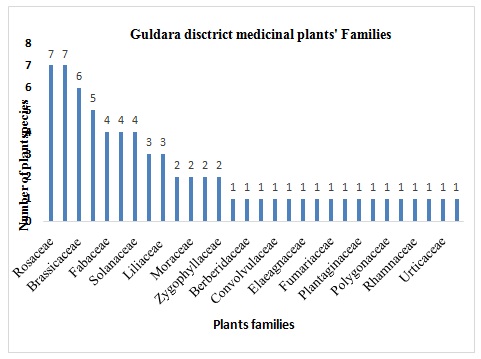
Figure 1: Data showing taxonomy of plants used traditionally in Guldara district.
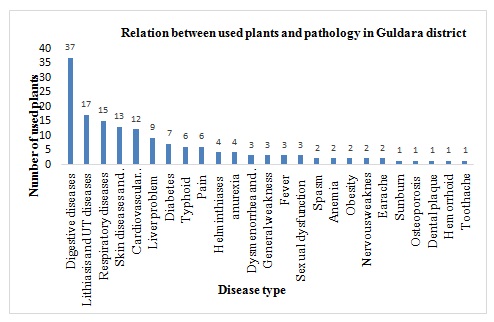
Figure 2: Data showing relation between used plants and pathology of Guldara district.
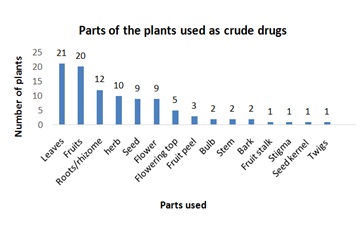
Figure 3: Data showing the plant parts used in Guldara district.
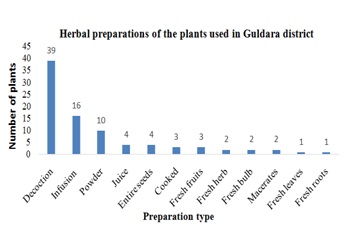
Figure 4: Data showing the preparation types of plants used in Guldara district.
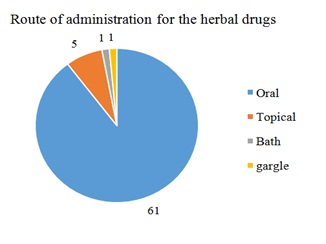
Figure 5: Route of administration of the plants used in Guldara district.
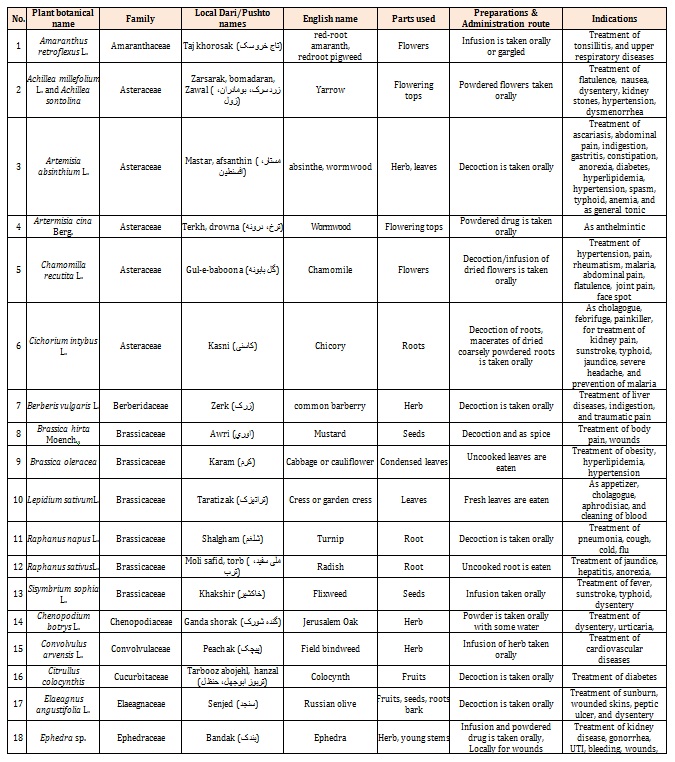
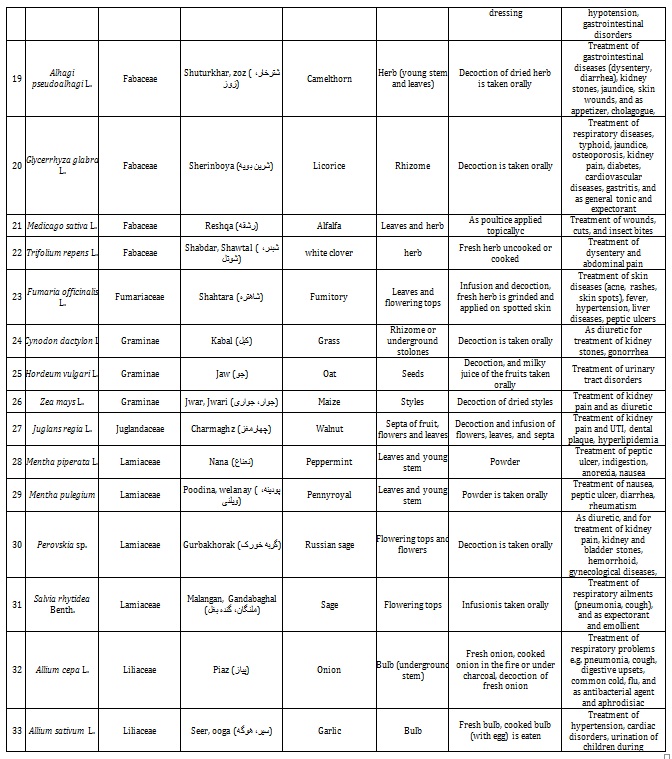
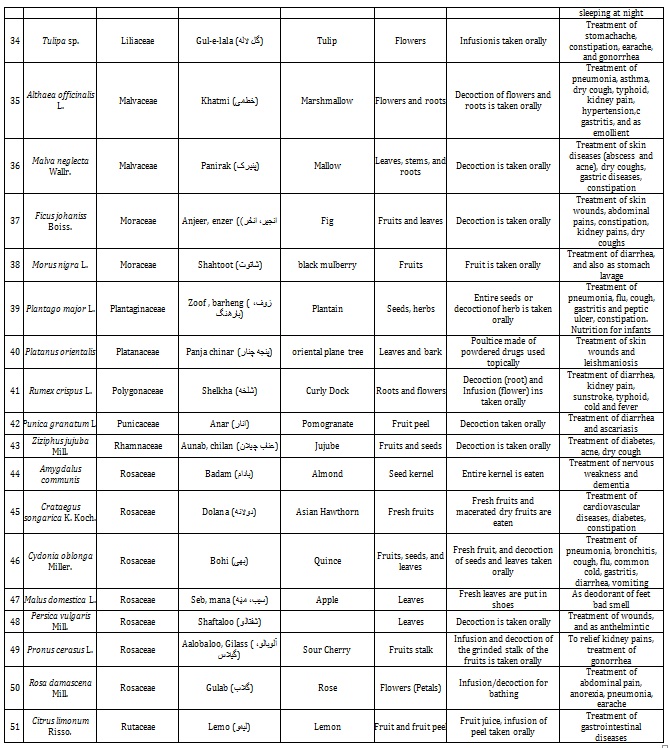
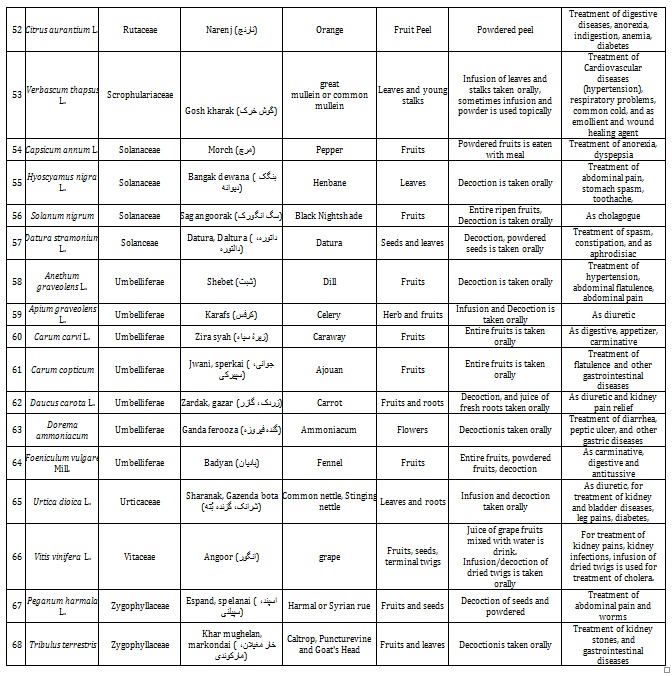
Table 1: Data showing the list of plants used in Guldara district for treatment of various routine ailments.
Chat with us on WhatsApp